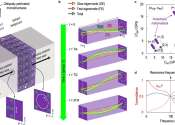Mystery solved: The case of the slipping finger
Haptics researchers have long known that applying ultrasonic vibrations to a flat, featureless glass plate makes it feel slippery. But they have also long debated why this occurs.
Aug 2, 2016
0
84
Engineering

Haptics researchers have long known that applying ultrasonic vibrations to a flat, featureless glass plate makes it feel slippery. But they have also long debated why this occurs.
Aug 2, 2016
0
84
Engineering

The soft whirring sound of low-frequency vibrations cannot be easily detected because it is not loud. But once detected, it can be hard to ignore. Often, residents complain of the annoyance caused by low-frequency vibrations ...
Sep 22, 2022
0
46
Engineering

A high-efficiency circular vibration/polarization ultrasonic conversion technology capable of detecting internal fractures, which can occur in various directions within a structure, has been developed by a joint research ...
Feb 14, 2024
0
43
Engineering

The water supply network is closely connected to all aspects of society. Acoustic methods could be applied to underground pipe network monitoring and leakage detection through measurements using acoustic/vibration sensors ...
May 18, 2020
0
8
Software

Vibrations during 3D printing either slow down the process or warp the parts, but new software could enable manufacturers to keep up the speed without sacrificing accuracy.
May 17, 2022
0
35
Robotics

Researchers have created a new type of tiny 3-D-printed robot that moves by harnessing vibration from piezoelectric actuators, ultrasound sources or even tiny speakers. Swarms of these "micro-bristle-bots" might work together ...
Jul 17, 2019
0
135
Engineering

The roar of a jet or race car engine can nearly take one's breath away. Now imagine trying to hear through all that noise to pinpoint a problem with the engine—and stop a potentially disastrous failure.
Nov 1, 2019
0
3
Hardware

A research team led by Professor Kaiji Sato (Robotics and Mechatronics Laboratory, Department of Mechanical Engineering, Toyohashi University of Technology) revealed a method for designing with ease an ultra-precise positioning ...
Feb 7, 2023
0
4
Electronics & Semiconductors

The energy demands of today's ubiquitous small electronic devices—including sensors, data transmitters, medical implants and 'wearable' consumer products such as Fitbits—can no longer be met by chemical batteries alone. ...
Apr 18, 2024
0
30
Energy & Green Tech

Rubber duckies could soon be at the forefront of an electronic revolution. In ACS Sustainable Chemistry & Engineering, scientists report they have used specialized nanogenerators that gather energy from mechanical vibrations ...
May 9, 2018
0
21